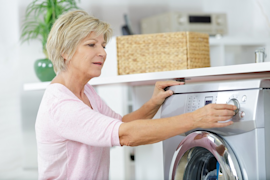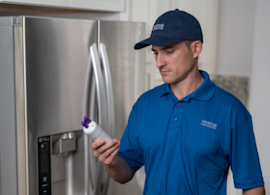
Clothes washers are available in 2 main designs—front-load and top-load. Parts such as drive motors and water valves are common to both types of washers. Some parts are specific to front-load washers and other parts described below are only in top-load washing machines.
Replacement parts common to all types of washers
Washers all perform these same basic functions whether they’re top-load or front-load:
Fill with water.
Agitate or tumble clothes to get them clean.
Drain out the wash water.
Fill with rinse water.
Agitate or tumble clothes to rinse out detergent.
Drain the rinse water.
Spin the clothes to eliminate as much water from the fabric as possible.
Because washing machines all perform these basic functions, they’ll have these common parts.
Outer wash tub
The outer tub houses the spin basket and holds water during the wash cycle. The back of the outer tub in a front-load washer has bearings and water seals. The bearings support the spin basket shaft and the water seals prevent water from leaking through the opening for the shaft. Top-load washing machine outer tubs have similar support bearings and water seals for the motor drive shaft that goes through the bottom of the outer tub.
Outer wash tubs are typically made of heavy plastic to hold water and support the spin basket during washing.
Spin basket
The spin basket is the perforated tub that holds the laundry load inside the washer. In a front-loading washer, the spin basket has the drive shaft attached and baffles inside the basket catch and tumble clothes as the basket rotates in the wash mode. In many top-load washers, an agitator or impeller attaches to the motor or gearcase drive shaft. The agitator or impeller move the clothes around during the wash mode in a top-loading washing machine.
Water inlet valve assembly
The water inlet valve assembly, which is electrically operated, controls water flow into the washer. It has a solenoid coil that opens the valve to allow water flow when the main electronic control board or timer applies voltage to the solenoid coil.
Water-level pressure switch
The water-level pressure switch, senses, controls and maintains the water level in the outer wash tub. The pressure switch senses the water level through an air tube attached to the bottom of the tub. As the tub fills with water, air pressure in the air tube pushes up on a diaphragm inside the water-level pressure switch. A post attached to the diaphragm opens and closes electrical contacts inside the body of the water level pressure switch to control the water fill and to shut off the water when the washer is full.
Water supply hoses
The water supply hoses, also called fill hoses or inlet hoses, carry water from the house plumbing to the washer. Each washer has a separate hose for hot and cold water. One end of the water supply hoses connects to the house's water supply valve and the other to the water inlet valve assembly on the back of the washer.
Drain pump
The drain pump removes water from the washer during the wash and rinse cycles. The drain pump on some front-loading washing machines has a large item filter that needs to be cleaned out periodically. You may find coins, bobby pins or other items in the large item filter if your washer has a drain pump with this type of filter. Follow the directions in the owner’s manual to clean the drain pump filter in your model.
Drive motor
The washer drive motor rotates the spin basket. It also drives the agitator in top-load washers. In front-load washers and some top-loaders, the drive motor rotates the spin basket in the wash portion of the cycle. In direct-drive front-load washers, the drive motor’s rotor is directly attached to the drive shaft. Some top-load washers have a similar direct-drive system. On some direct-drive top-loading washing machines, the drive motor shaft connects directly to the gearcase.
Drive pulley
The drive pulley is mounted at the bottom or back of the washer tub and is rotated by the drive belt and drive motor. The drive pulley rotates the spin basket when the washer is in spin mode for all washers. It also rotates the spin basket in front-load washers and some top-load washers in the wash mode. The drive pulley moves the agitator or impeller in belt-drive top-loading washing machines.
Drive belt
The washer drive belt connects the drive motor to the drive pulley in the washer to spin the basket. The drive belt connects the drive motor to the gearcase pulley in some top-load washers.
Shock absorbers
The shock absorbers in a washing machine absorb the vibrations and movements of the outer washer tub. The shock absorbers also help hold the outer tub in place to prevent damage while allowing reasonable movement during spin and wash modes.
Leveling feet
Leveling feet, also called height adjustment feet, are used to level the washing machine. The feet screws change the feet's height, ensuring that the washer can be properly leveled. It is important to level the washer to prevent vibration.
Main electronic control board
The main electronic control board, also called the mother board, governs the timing and execution of the washer component functions. It controls the fill valves, the drive motor and the drain pump. You’ll likely need to replace the main electronic control board if it's getting 120 -volt power but doesn't operate or if it isn't properly controlling the functions it governs.
User interface board
The washer user interface board houses the buttons you press to set up and start the wash cycle. When buttons stop working on the user interface board, you’ll likely need to replace it.
We have DIY repair help available for symptoms common to all washing machines such as Why won't my washing machine fill? Follow the troubleshooting steps described in our repair help to find out which part you need and order the part for your washer. Key the model number of your washer into the search bar at the top of the page to see a part diagram and list of parts for your washer. Order the part you need and follow the steps described in our repair guides to install the part yourself. If you’re not confident that you can safely repair your washer on your own, have a service technician fix your washer.
Front-load washer parts
Front-load washing machines use some different parts that you won’t find on top-load washers. Because the tub in a front-load washer is mounted horizontally inside the cabinet, front-loaders have doors instead of lids.
Here are some common front-load washer parts.
Door lock assembly
The door lock assembly on locks the washer door to prevent the door from opening during the wash cycle or the high-speed spin cycle. The door lock assembly includes door latch that fits into the lock, which grabs the door latch, and a switch that signals to the control system whether the washer door is closed or open, locked or unlocked.
Door strike
The door strike, which is attached to the front load washer door, is part of the door lock system. The door strike pushes into the door latch when the door shuts. The locking mechanism in the door lock assembly clasps the door strike to prevent the door from opening during the cycle.
Door boot
The door boot is a bellow-shaped gasket between the door and the drum of a front-load washer that prevents leaks. The door boot—also called the door boot seal or door gasket—is flexible so it isn't damaged as the outer tub tumbles and spins.
Motor control board
The motor control board is a circuit control board in a front-load washer that's usually in the bottom of the washer next to the drive motor. It monitors and controls the drive motor speed and direction for the tumble and spin actions during the cycle.
Top-load washer parts
Most top-load washing machines have an agitator or impeller inside the vertically mounted tub. Top-load washers often have different drive systems than front-load washers.
Here are the most common washer replacement parts unique to top-load washing machines.
Agitator
The agitator is mounted inside the spin basket of a top-load washer. The agitator rotates back and forth to moves the clothes inside the spin basket to clean the load. Replace the agitator if it's cracked or broken, or if the top part of the agitator is not ratcheting properly, which indicates damage to the teeth that engage the agitate dogs.
Agitator dogs
Agitator dogs are small cams, located within the top half of the agitator, that control the agitator's movements. The dogs ratchet across the gear teeth in one direction and dig into the gear teeth in the opposite direction to create the agitation that moves the clothes through the wash tub.
Lid switch
The lid switch is a safety mechanism on a top-load washer that detects whether the lid is open or closed. When the lid is open, either the spin basket won't spin or the drive motor won't run, depending on the model.
Lid lock assembly
Some top-load washers use a lid lock to keep the lid shut during the cycle because the basket spins at high speeds and can cause serious injury if you reach your hand or arm down into the tub while the basket is spinning. The lid lock assembly detects whether the lid is closed and locked during the cycle.
Top-load washers use various drive systems to rotate the spin basket and drive the agitator or impeller. Some older Kenmore and Whirlpool washers use a direct-drive transmission while newer Kenmore, Whirlpool, Maytag and Amana washers often use a VMW (Vertical Modular Washer) drive system.
Gearcase
In a direct-drive top-load washer, the gear case drives the agitator and the spin basket. The washer gear case has internal gears that create the agitation motion. For the spinning motion of the spin basket, it shifts the drive shaft and spins the drive tube. In a vertical modular top-load washer, the gear case drives the impeller and the spin basket in the washer. The shifter assembly shifts the gear case between the agitation and spin modes in a vertical modular top-load washer.
Shifter assembly
The shifter assembly—also called the actuator—in a top-load washer is mounted on the bottom of the gearcase on VMW washers. The shifter assembly's motor shifts the drive system between the agitation mode and the spin mode during the cycle. A sensor on the shifter monitors the position of the drive system and shuts the washer down if the shifter malfunctions.
Replacing the shifter assembly is one of the most common top-load washer repairs. Here’s a video that shows how to replace the shifter assembly:





